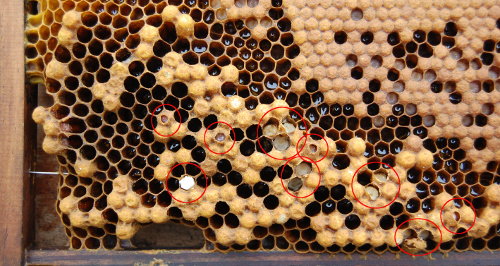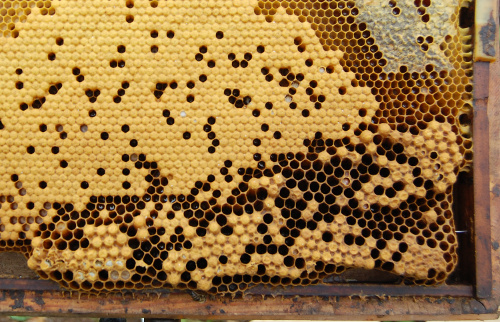In this way SC bees fight against Varroa mites – Investigation of survivor colonies
For over a year now we made intensive studies how our small cell colonies (SC = small cell) defend against the Varroa mites, without any treatments:
- How do SC bees defend against Varroa mites?
- first investigations of our hives for VSH (in german)
- Does the drone brood act as a Varroa trap in small cell bees?
Now I have closely examined a survivor colony and in addition it is also a breeder colony that unites very good properties.
Results:
- Varroa is very little present in the small cell worker bee brood and there only a quarter of them have female offspring
- The Varroa mites focus on the drone brood
- However, only 43% of the drone brood cells are infected by Varroa mites, but by multiple occupation.
- Through multiple occupation of the drone brood cells the proliferation of the mites is reduced – 52 mother mites have only 52 female offspring, what should have a bigger ratio in the drone brood than 1: 2.
- The occupied drone brood cells by Varroa mites are opened by the bees within a very short time (in 3 days 59% and within 6 days 95% of the occupied drone brood cells) and the brood of Varroa mites is interrupted and destroyed.
- this is nothing new because Ed&Dee Lusby are telling us the same story now for many years and I can fully confirm what they say.
On 4.3.2015 I started the investigation of the hive N° 35sa. It went on 2 supers over the winter, with a lot of food reserves and is located at a beeyard with other 35 colonies. Of these other colonies quite a few had Varroa problems last year caused by improper breeding selection of my hand. But the stock still never had problems with the Varroa mite and 35sa is a survivor colony that had never been treated. This means that the Varroa pressure on this colony must have been pretty strong last year. And yet it has survived very good without any intervention or treatment.
But how?
Hive N° 35sa
4.3.15
I opened 100 worker brood cells with bee pupae that had purple eyes and so they were 15 days old (according to the VSH test of Harbo)
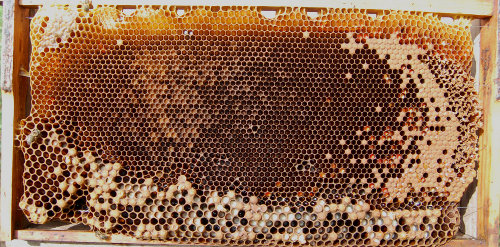
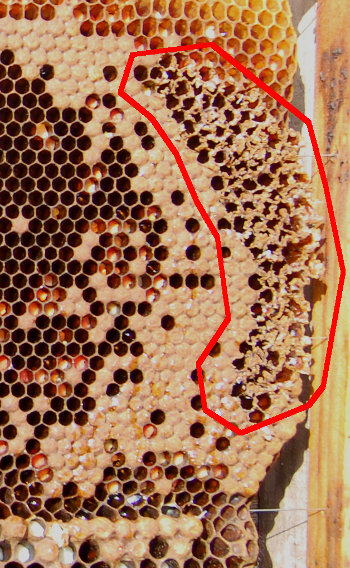
I found the following in the 100 opened worker brood cells:
| Varroa |
female offspring |
male offspring |
| 1 | 1 | yes |
| 1 | – | – |
| 1 | – | yes |
| 1 | – | yes |
| 4 | 1 |
In the 100 opened worker brood cells I found only 4 Varroa mites, 3 of those had no female offspring, one had no offspring at all and only one had a female daughter. So in 100 cells I found only one female offspring of a Varroa mite.
This means that almost all Varroa pressure must be found in the drone brood.
So I was looking for combs with drone brood.
In the hive I found 2 combs which had quite some drone brood and 3 had comparable few drone brood. One comb had about 200 capped drone brood cells per side, the other about 110 per side, together about 620 drone brood cells. In addition there were about 90 capped drone brood cells on the other 3 combs. I found in total about 710 capped drone brood cells in the hive.
I opened some drone brood cells, but the drone pupae were too young to make a reliable statement about the Varroa offspring. All capped drone pupae had about the same age on this comb, they were now a pupae with white eyes.
But I saw 7 cells with hygienic behavior in the drone brood. This means that the bees had opened the capped drone brood cell to clean out the Varroa mites:
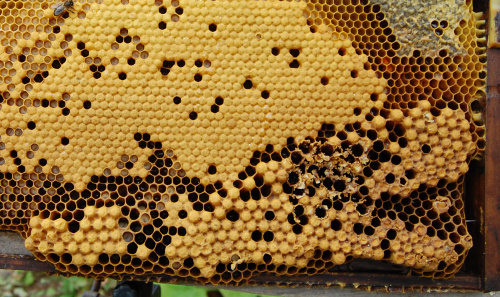
Of these 7 drone brood cells, that were already opened by the bees (with white eyed pupae), 3 were totally chewed out and 4 only recently opened. I still found 2 or 3 mother mites per cell, but the offspring were still very young and small through the young age of drone pupae.
So I waited for 3 days until the drone pupae had violet eyes.
On 7.3.15 I investigated the same comb and found again hygienic behavior in both the worker bee brood and in the drone brood.
(click on the image to enlarge)
On one side of the comb I found 11 opened drone brood cells and on the other side of 12 and 5 totally chewed out cells, together 28 drone brood cells opened by the bees.
In all such cells that were opened by the bees, I found that there had been Varroa mites present.
In these drone brood cells, opened by the bees, I found 4 cells each with 4 mother Varroa mites and 2 to 3 female offspring, 2 cells with 3 mother Varroa mites and 4 resp. 2 female offspring, 1 cell with 2 Varroa mites and 2 female offspring and 4 cells with only one mother mite, 2 had no female offspring, one had 7 female offspring and one had no offspring at all. A total of 11 cells with 24 mother mites and 24 female offspring. This means that we find again a frequent multiple occupation of drone brood cells by mother Varroa mites.
It must be said that I have observed that, although the cells were opened by the bees, the mother Varroa mites have not moved out of the cells. Often you can see that even a mother Varroa mite pecks an offspring and carries it around. It seems that they want to protect it. Thus, one can still find the Varroa families in cells in which the bees have completely chewed out the bee pupa, until they are then attacked by the bees.
I opened 58 capped drone brood cells with pupae that had violet eyes.
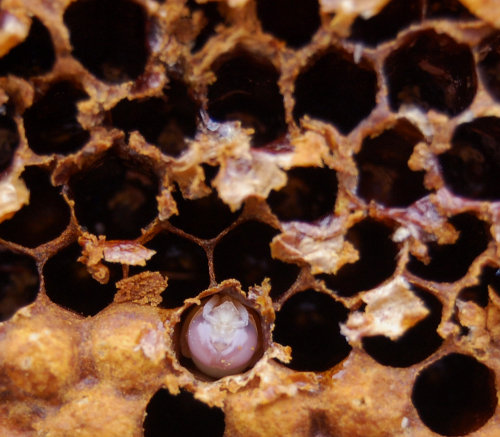
and I found in 33 drone brood cells no Varroa mites and in the remaining 25 cells I found this:
| 1 | 2 | yes | 3 | – | yes |
| 2 | – | yes | 3 | 1 | yes |
| 2 | 2 | yes | 2 | 3 | yes |
| 1 | – | yes | 1 | 1 | yes |
| 1 | 3 | yes | 4 | 5 | yes |
| 1 | 2 | yes | 1 | 2 | yes |
| 5 | 4 | yes | 2dead | – | – |
| 2 | 3 | yes | 1 | 2 | yes |
| 4 | 2 | yes | 2 | 2 | yes |
| 2 | 3 | yes | 3 | 5 | yes |
| 1dead | – | – | 2 | – | yes |
| 2 | 4 | yes | 1 | 3 | yes |
| 3 | 3 | yes | |||
| total | 52 | 52 |
That is to say that I found again multiple occupation of Varroa mites in the drone brood, although more unoccupied drone brood cells were available than occupied ones.
In the 58 opened drone brood cells I found 52 mother Varroa mites with a total of 52 female offspring.
Now, however, I noticed that the breeding image was more punctured than 3 days ago. On 4.3. I found on this side of the comb 7 opened drone brood cells by the bees through hygienic behavior. Today there were 11 on the same side of the comb.
This is the brood image on 4.3.

and this is the brood image on 7.3.
(click on the image to enlarge)
which means that the bees have removed in the last 3 days some cells that were occupied with Varroa mites.
Here you can see which cells these are:
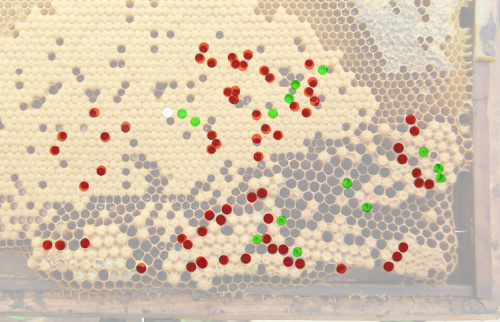
labelled green are the cells that have just been opened by the bees and which all contained Varroa mites, as described above.
labeled red are the cells that were cleared in the last 3 days.
This means that in the last 3 days, 33 drone brood cells were additionally cleaned, which were occupied by Varroa mites.
On this side of the comb there were approximately 200 capped drone brood cells on 4.3.
Of these, 7 have been opened by the bees and on day 7.3. they have opened 11. This is a total of 7 + 11 + 33 = 51 cleaned cells.
If we assume that of the 200 capped drone brood cells only 86 were occupied with Varroa mites (in the above given ratio 33:25) and 51 have already been cleaned by the bees, then there remain only 35 drone brood cells that are occupied with Varroa mites.
Thus the bees have opened in the last 3 days 59 percent of the capped drone brood cells that were occupied with Varroa mites, thereby disrupting and destroying the brood of Varroa mites.
Since in the worker bee brood very few Varroa mites were found and we still found several opened and cleaned cells on this comb in the worker bee brood find (33 cleaned cells in the last 3 days and 6 recently opened), it can be assumed that more than 90 % of Varroa mites must be concentrated in the drone brood.
Further investigation, again three days later, on 10.3.2015:
after 3 days I found the following drone brood picture on the same honeycomb:
(click on the image to enlarge)
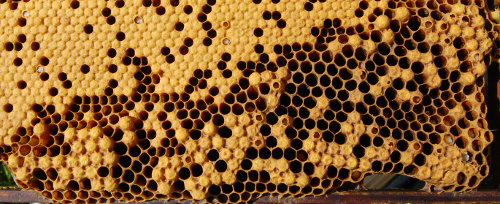
I found now another 19 opened cells by the bees through the hygienic behavior.
In the last 3 days they had cleaned out 12 more drone brood cells, what can be seen here:
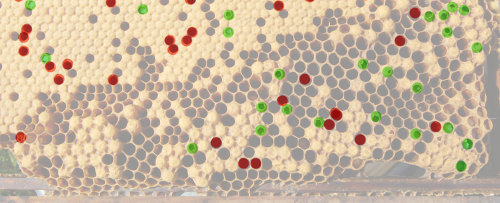
12 cells labelled in red that have been cleaned in the past 3 days and 19 cells labelled in green, who have just been opened by the bees to remove them.
This means that from the 200 capped drone brood cells that were found on this comb 9 days ago, approximately 86 were occupied by Varroa mites, of which in the first 3 days already 51 were cleaned out and now again 31 have been chewed out. So now only about 4 capped drone brood cells remain which are occupied with Varroa mites.
This means that this hive has virtually stopped almost all Varroa breeding in this drone brood, which must have been about 76 Varroa mites with 76 female offspring.
So the bees have opened in the last 6 days 95 percent of the drone brood cells that were occupied with Varroa mites, thereby disrupting their brood and destroyed it.
Results:
- Varroa is very little present in the small cell worker bee brood and there only a quarter of them have female offspring
- The Varroa mites focus on the drone brood
- However, only 43% of the drone brood cells are infected by Varroa mites, but by multiple occupation.
- Through multiple occupation of the drone brood cells the proliferation of the mites is reduced – 52 mother mites have only 52 female offspring, what should have a bigger ratio in the drone brood than 1: 2.
- The occupied drone brood cells by Varroa mites are opened by the bees within a very short time (in 3 days 59% and within 6 days 95% of the occupied drone brood cells) and the brood of Varroa mites is interrupted and destroyed.
- this is nothing new because Ed&Dee Lusby are telling us the same story now for many years and I can fully confirm what they say.
Important note:
This small cell hive is a survivor colony that has never been treated. Here you can see that the Varroa mites go almost exclusively into the drone brood. But that is not to say that in all small cell hives worker bee brood is spared. It is very important that we teach the bees again to apply the right amount of drone brood per comb. If we do that, we have all year round temperate drone brood in the hive. But there are also many hives who do not act as well as this colony and despite the small cells, we can get a dangerous accumulation of Varroa mites in the bee brood.
But it is beyond discussion that only the smaller cell size causes hygienic behavior in big amount. The hygienic behavior in the drone brood was not encountered in studies of J. Harbo because he worked with normal large cell bees. In these small cell survivor colonies, however, the hygienic behavior in the drone brood is the decisive mechanism for the bees to fight back the Varroa mites.

